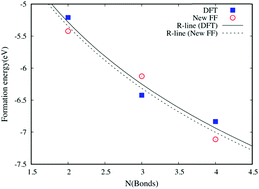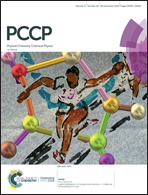Modified potential for atomistic simulation of the growth of carbon materials from binary alloy catalysts†
Abstract
A new hybrid bond order potential has been developed and implemented to describe carbon–bimetallic alloy interactions, which are involved in the catalytic growth of carbon materials such as graphene and carbon nanotubes on the surface of binary alloy catalysts. In carefully adjusting the parameters, the potential energy fitting correlated with the results calculated from the density functional theory (DFT) method leads to a high quality empirical force field with an average error of <4.5% only. With the PES accuracy, in total 16 (n,m) have been successfully obtained from the MD trajectories in this work, and the structural evolution including random chirality and diameter formation has been identified. The newly modified force field is expected to be useful for modelling the spontaneous growth of carbon materials, particularly tubes on binary alloy clusters, giving an idea of how these C–C, C–M, and M–M interactions affect the growth behavior of carbon nanotubes. In addition, the new FF is only valid for liquid alloy nanoparticles at this time, but the use of solid alloy nanocatalysts with the new FF can be further employed for 2-D material growth such as graphene layer growth.



 Please wait while we load your content...
Please wait while we load your content...